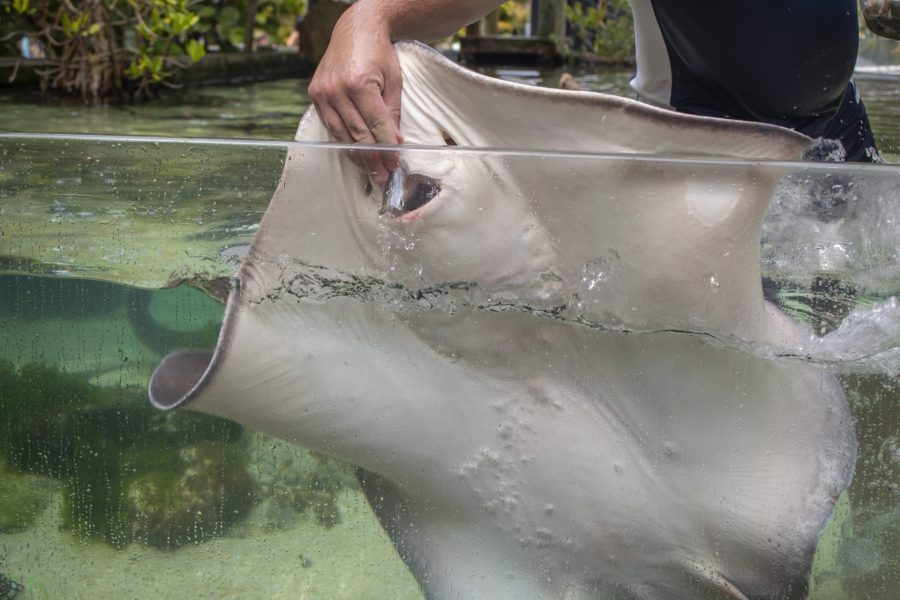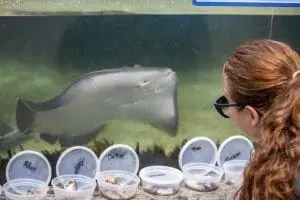

Learn more about mealtime with our stingrays below!
Feeding a stingray takes a little more effort than leaving food out or sprinkling it into our Indian River Lagoon aquarium!
Just like people, our animals need a well-balanced diet. Our commissary team works closely with our animal care and veterinary teams to ensure that everything on the menu for our animals is healthy and enriching. Read on to learn more about mealtime with our rays!
What’s on the Menu?
 Each of our eight rays – two Atlantic stingrays and six Southern stingrays – is hand-fed to make sure each is receiving their recommended diets. By feeding them individually, our Herps & Aquatics team can also do physical checks, ensuring everyone appears healthy, has a healthy appetite, and is showing normal behaviors. The rays receive 4-6% of their body weight in food per week, adjusted based on their body condition score and size of their liver. Stingrays actually store all of their body fat in their livers! A healthy stingray will have a liver that fills most of their body cavity, which we can measure with an ultrasound during regular physical exams.
Each of our eight rays – two Atlantic stingrays and six Southern stingrays – is hand-fed to make sure each is receiving their recommended diets. By feeding them individually, our Herps & Aquatics team can also do physical checks, ensuring everyone appears healthy, has a healthy appetite, and is showing normal behaviors. The rays receive 4-6% of their body weight in food per week, adjusted based on their body condition score and size of their liver. Stingrays actually store all of their body fat in their livers! A healthy stingray will have a liver that fills most of their body cavity, which we can measure with an ultrasound during regular physical exams.
So, while the food items that we are feeding each of the rays – fish, squid and shrimp – are the same, the volume is different since we have rays of many different sizes!
“Variety isn’t just the spice of life, it is essential for a well-balanced diet,” said Nicole Moyer, area supervisor of our Herps & Aquatics team.
Many of our stingrays have preferences for what they like to eat. Shrimp is usually a favorite for everyone, while certain fish are hit or miss. If the “wrong” species of squid is offered, they won’t touch it or anything else it touched! Our Herps & Aquatics team gets to know each ray individually and try to adjust their diet to still be balanced – but not too heavy on items they often refuse. Still, they try new foods several times before ruling anything out!
“And their preferences can and do change over time,” Nicole said. “Our youngest, Wheeler, used to refuse absolutely everything but shrimp, but as he has grown up a bit, he has expanded his tastes.”
Second Breakfast
Our rays are usually fed twice a day. They are naturally very good at regulating their appetite and don’t tend to overeat. Our Herps team prepares the day’s allotment, and the rays eat what they’re hungry for in the morning, then have whatever is left in the afternoon.
Their care team often mixes things up in the afternoon by putting their food into puzzle balls or other enrichments, which encourages natural foraging behaviors!
Take Your Vitamins
Usually during the rays’ morning meal, they receive a vitamin called a Mazuri Shark and Ray Supplement. The dosage is based on how much food they eat, which adds another reason to weigh out the portions.
It’s a multivitamin with a strong focus on being an iodine, vitamin E and thiamine supplement. Iodine is essential for stingray thyroid health – similar to us, it’s actually the reason we iodize table salt! Iodine naturally occurs in their environment and in their foods, but it can be removed when food is frozen or through our water filtration system, so we add it back in with the vitamin tablets.
We hope you’ve enjoyed learning more about mealtime with our rays. While they aren’t fed at a set time each day, you may stumble across a feeding session during a walk through our Paws On loop to their habitat!
Brevard Zoo is an independent, not-for-profit organization that receives no recurring government funding for our operating costs. Your generous support enables us to continue to serve our community and continue our vital animal wellness, education and conservation programs.
